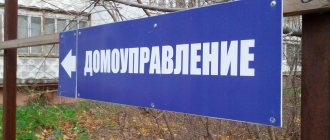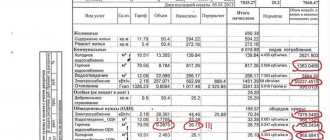Home / DHW
Back
Published: 12/09/2019
Reading time: 3 min
1
8696
Various abbreviations are written on receipts for housing and communal services. Some residents of apartment buildings located on the territory of the Russian Federation are interested in the question of what is cold water supply for hot water supply in the receipt.
Being able to decipher the abbreviations indicated in the payment document is necessary to control the correctness of charges.
- 1 What do cold water and hot water mean?
- 2 How the amount of water is calculated
- 3 Components of the cost of hot water supply
- 4 Legislative acts regulating the calculation
What it is?
Cold water for domestic hot water supply is the amount of cold water heated in boiler units in the basement of an apartment building and used by subscribers as regular hot water.
It is supplied to apartments through hot water risers and is taken into account by hot water meters. Only the tariffs differ, since regular cold water is supplied to the house itself.
Decoding and definition
Cold water for hot water supply is a flow that flows not into the cold water riser, but into the heaters . After preparation, he goes to the apartments via the hot water riser.
At the same time, a separate approach is required to calculate the payment, since before entering the house it is ordinary cold water, but a hot stream enters the apartment.
It is noteworthy that this volume is displayed by the DHW meter, but payment is made at a different tariff.
What does the line on the housing and communal services receipt mean and where is it located?
There is no special column “cold water for domestic hot water” in receipts. Most often there are two lines - “water” and “heating”. Sometimes they write “Hot water supply/water (or heating)” .
The costs of local heating are taken into account, which are determined by the type of equipment, technological features and other factors.
Dividing the tariff into 2 parts corresponds to the actual costs of suppliers and more accurately reflects the cost of the services received.
Understanding cold water metering
The legislator has established mandatory payments for citizens of the Russian Federation for the use of utility services. Continuous cold water supply (CWS) stands for continuous supply of a resource of appropriate quality to Russian citizens for use in everyday life. The state provides for the norm for each consumer and the delivery of water through the municipal system or to special pumps. Accounting for cold water must be carried out in the following ways:
- fixing a specific consumer norm for each person registered in a residential premises;
- providing any housing with a special meter.
The counter (KPU) measures the amount of cold water used per month, after which the data is transferred to the person who provides the service.
Important! A special designation “DPU” will appear in the payment, which indicates the obligatory amount for the use of cold water supply using a home meter.
In the absence of a meter, the determined consumption is calculated from general indicators. This option is not entirely profitable, since thrifty people will have to overpay for the service. The data from the residential premises is taken as a basis.
Consumption standards for general household needs
ODN are resources that are used to maintain property owned equally by all apartment owners.
For example, water used for such purposes as washing entrances, windows, staircases, etc.
There are no officially approved standards for ODN; they are adopted in each region based on local conditions and technological capabilities. The only limitation is the upper limit - the resources spent on ODN should not be more than the main resources used.
What does the total amount for payment consist of?
The total amount includes:
- amount of water according to the DHW meter;
- heating cost.
The tariff is created based on local factors:
- average temperatures, climate features;
- configuration and technical condition of the system;
- existence of a main hot water supply line;
- the presence of thermal insulation of risers and heated towel rails.
The total amount is the product of the volume of water and the tariff per unit (m3 or liter).
Water disposal
The fee for sewerage includes not only the direct drainage of water; in fact, it includes several services at once:
- drainage of domestic wastewater around the clock, that is, the same sewer system;
- their transportation within the boundaries of a populated area;
- further transportation outside the populated area.
Thus, the payment for sewerage means that the wastewater will not pollute the settlement in which you live - it is for work in this direction that it is charged.
How to calculate it yourself?
The calculation is done in 2 stages . First, the amount of water consumed is determined from the readings of the DHW meter.
To do this, the data at the beginning of the month is subtracted from the readings at the end of the month. The first three numbers on the scale (black) are taken into account.
The second step will be to calculate the cost of heating. To do this, you first need to determine the amount of energy used, then calculate its cost.
Formula and basic calculation rules
Main (basic) calculation formula: P =V * T, where:
- P—sum;
- V—water flow;
- T—tariff.
The amount of consumed thermal energy is determined using the formula: Q p = V hot water/n * q, where:
- Q p is the amount of thermal energy expended;
- V hot water/n—volume of water;
- q - specific energy consumption per unit volume (approved standard value in force in a given region).
The cost of heating is determined by the formula: P hot water/e = Q p * T te, where:
- P hot water/e is the cost of heating;
- Q p is the amount of thermal energy expended;
- Tte - tariff for used energy (approved by local governments).
A few examples
There are several calculation methods. Let's look at examples for different situations:
There are apartment meters (meters).
Then the calculation is made using the basic formula P =V * T. That is, the monthly indicator of the hot water meter is taken and multiplied by the sum of the cost of 1 m3 of cold water and the cost of heating this cubic meter.- There are no metering devices, there is no technical possibility of installing them.
Then the calculation is made based on the standards. Let's say there are 2 people living in an apartment. The cost of 1 m3 of cold water is 30 rubles. Standard consumption per person is 4 m3. Then the total consumption of hot water is 8 m3. This value must be multiplied by the sum of the cost of water itself and heating 1 m3. Let’s say heating costs 50 rubles/m3. Then the payment for hot water will be equal to 8 × (30 + 50) = 640 rubles. - There are no meters, but it is possible to install them. In this case, the calculation is first made in the same way as in the previous example, but then the amount is multiplied by an increasing factor. Let's say in the city it is 1.5. Then the cost of the service will be 640 × 1.5 = 960 rubles.
From these examples it is clear that installing a meter will help to significantly reduce the amount of payment for consumed water.
Do they have the right to charge for water heating?
The line “DHW” implies an accrual for the volume of water consumed during the month that passed through the hot water supply flow meter. If the water meter does not work or is not present in the home, then the volume of water calculated according to the average indicator or a unified standard taking into account the number of officially registered persons is taken as a basis. The volume of DHW supply is calculated according to the same scheme as the tariff for cold water supply.
There may also be cases when residents receive receipts with increased rates. In such situations, it is recommended to contact the management organization. You can visit its settlement department or write a letter demanding an explanation of why such amounts were accrued.
Hot water supply ODN in the receipt is a fee for the use of hot water for cleaning the entrances, as well as for heating them in the winter. The total amount of expenses for the month is distributed among all apartments of a residential building in proportion to their area. The number of registered residents in one apartment is not taken into account.
The question arises whether it is legal to charge one tax for sewerage. Most of the water supplied through pipes to apartments, after being used for laundry, dishwashing or hygiene purposes, is drained into the sewer system, which requires appropriate maintenance, just like the water supply system. The costs of this work must be borne by the residents themselves.
Unfortunately, some management companies, homeowners' associations and housing and communal services make money from the residents of apartment buildings and deliberately inflate the amounts in receipts. Those who do not know how to calculate water supply according to meters, or are not familiar with the standards, continue to overpay and do not even know about it. Unscrupulous management companies can and should be fought.
You might be interested ==> List of diseases for which a causal relationship is established for the liquidators of the consequences of the Chernobyl disaster
For example: from 2021, the water supply standard in Moscow is 11.68 cubic meters per person per month. If there are 4 people registered in the apartment, the payment will be calculated based on consumption 4 times more - that is, based on 46.72 m³. With a conditional tariff of 30 rubles, the amount to be paid will be 1401.6 rubles.
Despite the fact that the balance is most often used in accounting in housing and communal services, it also has its place. The designation of balance is account balances. The balance at the beginning of the previous month is the money that you have taken out in excess of the required amount and will now carry over to the next payment.
You can find such a designation in the first paragraph of the receipt for housing and communal services. As a rule, on a standard receipt the code is written in the upper corner and consists of a value from 8 to 10 digits. Each specific owner of the premises is assigned his own individual code, which serves as a so-called password or passport when paying for housing and communal services. Important! Sometimes the code may change. As a rule, this is due to internal changes in the structure of the management company or housing office. This occurs in a situation where an apartment building passes from the management of one company to the management of another. The management organization must notify residents that their individual codes will be changed.
The main advantage of a direct-flow water supply system compared to a circulating water supply system is its simplicity. There are no water coolers, circulating water pumping stations, additional pipe networks or other structures. If there is no need to purify industrial waste water, then the entire cold water supply system will consist of a pumping station and a system of supply and discharge pipelines. The advantage of a recycling water supply system is that a significantly smaller amount of water is supplied from the source than with a direct-flow system; this amount of water should only compensate for its losses from evaporation and carryover of droplets by the wind from the coolers and the water consumption for blowing cold water, which depends on the quality of the added water and the method of processing it. As a rule, the amount of water added to the system does not exceed 5% of the circulating water flow. With recycled water supply, the diameter of water pipelines, and therefore their cost, is significantly reduced, the size and cost of water intake structures and first-stage pumping stations are reduced, the energy consumption required to supply water to the territory of the enterprise is reduced, and it becomes possible to use sources with a small water flow rate for industrial water supply, The cost of treatment facilities for make-up water is noticeably reduced. With a recirculating system, much less waste water is discharged into the reservoir than with a direct-flow system. In this regard, the task of protecting water bodies from pollution by wastewater is simplified, the size and cost of treatment facilities and pipelines discharging waste and treated water are reduced.
To encourage citizens to install meters, increasing coefficients are applied, legally limited to 1.5. Therefore, the amount to be paid, calculated according to the standards, will always be higher than the actually spent resources determined by the meter.
- In a situation where, for some reason, the house is not equipped with a central water supply, the supplier undertakes to supply water to the appropriate water stand.
- Part of the cold water is also used for general house needs and is paid for by residents.
According to the current legislation, certain standards have been established that must be complied with. The law also provides for situations regarding planned shutdowns of water supply for various types of preventive work.
You might be interested ==> Analysis of Raskolnikov’s Confession to Sonya









